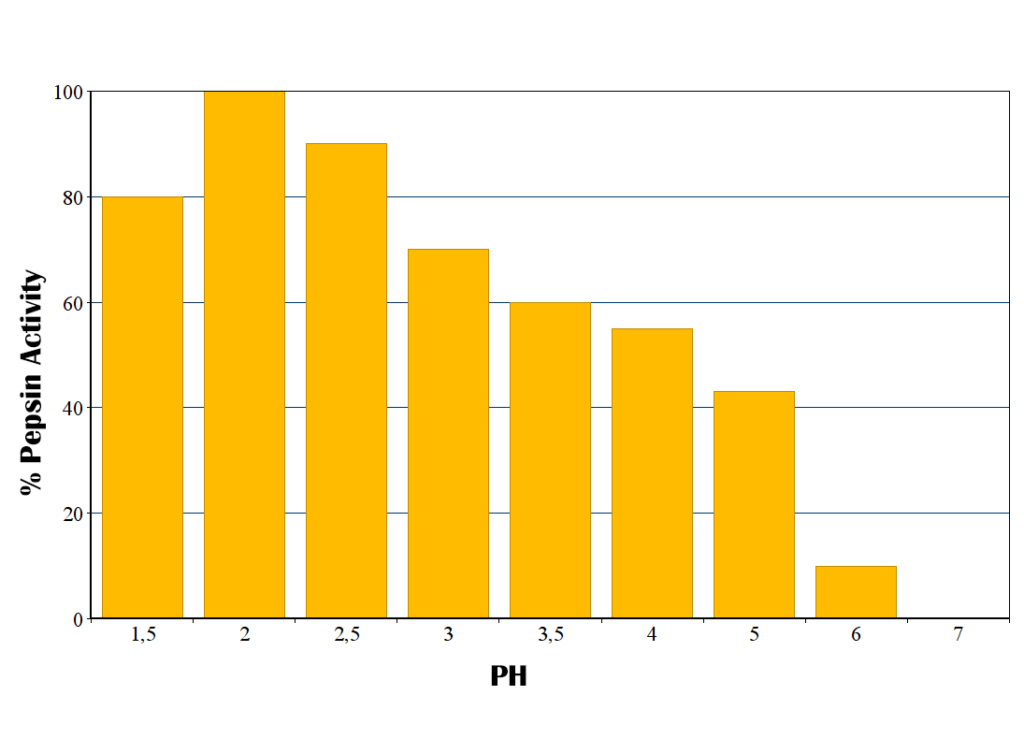The pH is a measure of acidity. Acids play a crucial role in the development of acid reflux symptoms.
What is the pH value?
The pH indicates how acidic or basic (alkaline) something is. The pH scale ranges from 0 to 14. The smaller the value, the more acidic, and the higher the value, the more basic is a liquid.

It is vital to be aware that the pH scale is logarithmic. This means that with each number on the scale, the acidity changes by a factor of 10. A change of two integers already reflects a 100-fold difference, and a change of three integers a 1,000-fold difference, etc. This means that pH 3 is 100 times as acidic as pH 5. For this reason, even a small numerical change in pH can make a big difference.
The relevance of the pH for reflux
Reflux is the rising upward of stomach acid and digestive enzymes. First, reflux reaches the esophagus, where it causes heartburn and other symptoms.[1]
Reflux can also be gaseous and can reach the throat and airways. This kind of reflux is known as laryngopharyngeal reflux (LPR), or silent reflux because it causes non-specific symptoms.
In both kinds of reflux, symptoms are caused either directly or indirectly by acid. The mechanism, however, differs.
Heartburn through irritation of the esophagus
Gastric juice has a pH of between 1.5 and 3.5, which means that it is very acidic.[2] In contrast to the stomach, the esophagus is not well protected against acid and is sensitive to contact with gastric juices. Consequently, typical symptoms, such as heartburn, occur when such contact occurs.
Frequent heartburn sensitizes the pain receptors of the esophagus. As a result, even moderate pH can cause symptoms.[3]
Activation of pepsins in patients with silent reflux
In the case of silent reflux, pepsin that is carried along with the reflux into the throat and airways irritate the mucous membranes.
Pepsin is an enzyme that breaks down proteins in the stomach. Because the stomach is acidic, it is active in a low-pH environment. Pepsin can be active up to a pH of 6.5, but the pH in the throat is usually higher (less acidic), so it is inactive there.[4]

However, in people with silent reflux, fresh acid reflux continually reaches the airways. The pH in the airways consequently drops, and as a result, pepsin gets activated and causes damage. LPR symptoms, such as hoarseness, cough, asthma, and mucous obstruction occur.[5]
Acidic foods can also activate pepsin on their way to the stomach, which is why acidic fruits and sodas are not recommended for people with silent reflux.[6]
The pH of so-called alkali-forming foods
Reflux patients should avoid acidic foods. That’s commonly accepted, but unfortunately, there is some misleading information regarding the acidity of foods.
This is based on the Alkaline Diet trend, which claims that alkali-forming foods are healthy. Some foods (especially protein-rich foods) are said to create acids, causing an acidification of the body. The alkaline diet tries to avoid precisely this.
Acid formation refers to metabolic processes that occur after digestion. This has nothing to do with the actual pH of the foods, though. Two examples of this are apple cider vinegar and lemons. They both have a low pH but are known as alkali-forming foods.
Whether or not the alkaline diet provides health benefits is a controversial topic. My concern is that it creates a lot of confusion among my readers when talking about pH and reflux.
For reflux, only the pH of the undigested food is relevant. The acidity of food while passing down the throat is what matters.
How to find the pH of food
The pH of foods is not easy to find. When looking for it online, you find only lists that fit into the above-described category of acid- or alkali-forming foods.
You can, however, measure the pH of foods yourself by using litmus paper, which you can find in pharmacies.
In my online course about the treatment of silent reflux, I also provide an extensive list of foods and their pH, which I tested myself and compared with other sources.
References
[1] Bennett JR. What is physiological gastroesophageal reflux? OESO foundation. https://www.hon.ch/OESO/books/Vol_3_Eso_Mucosa/Articles/ART008.HTML. Mai 1994. Abgerufen am 21.06.2019.
[2] Michael M. Stomach acid test. MedlinePlus. https://medlineplus.gov/ency/article/003883.htm. 27.10.2018. Abgerufen am 21.06.2019.
[3] Yamasaki T, Fass R. Reflux Hypersensitivity: A New Functional Esophageal Disorder. J Neurogastroenterol Motil. 2017;23(4):495-503.
[4] Johnston N, Dettmar PW, Bishwokarma B, Lively MO, Koufman JA. Activity/stability of human pepsin: implications for reflux attributed laryngeal disease. Laryngoscope. 2007;117(6):1036-9.
[5] Koufman JA. The otolaryngologic manifestations of gastroesophageal reflux disease (GERD): a clinical investigation of 225 patients using ambulatory 24-hour pH monitoring and an experimental investigation of the role of acid and pepsin in the development of laryngeal injury. Laryngoscope. 1991;101(4 Pt 2 Suppl 53):1-78.
[6] Koufman JA. Low-acid diet for recalcitrant laryngopharyngeal reflux: therapeutic benefits and their implications. Ann Otol Rhinol Laryngol. 2011;120(5):281-7.

